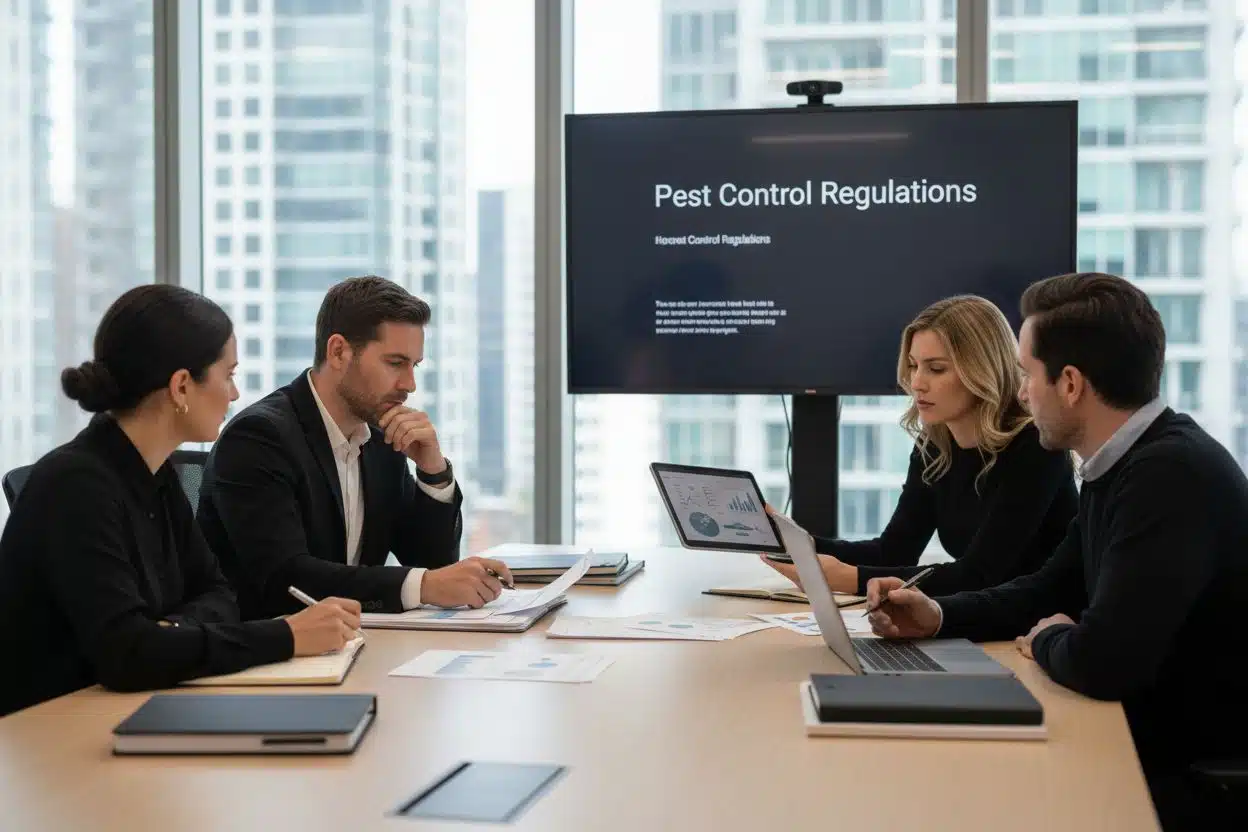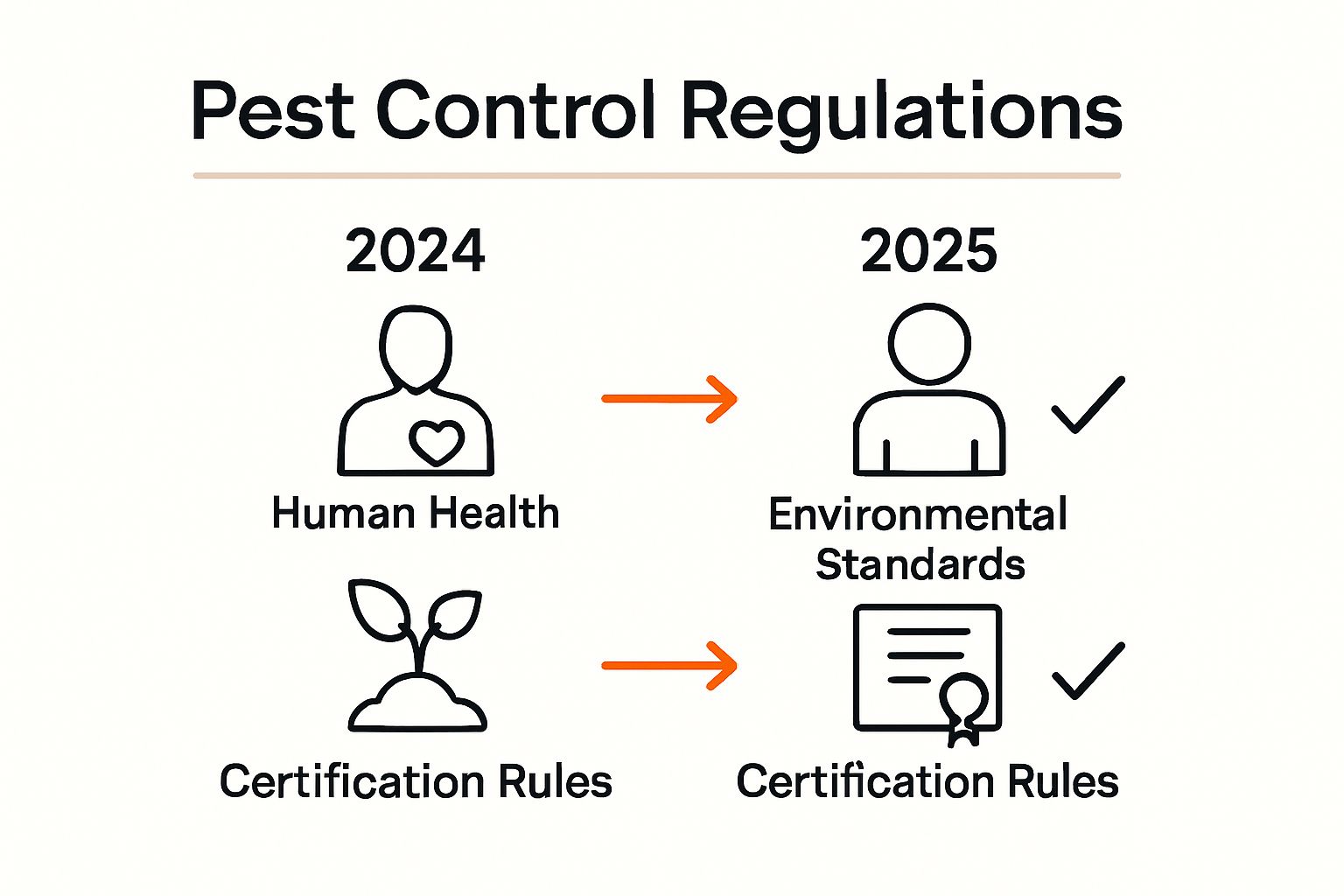
Pest control regulations might sound like just another set of government rules, but their impact reaches much further than most people realize. Over 1 billion pounds of pesticides are applied in the US every year, and strict regulations decide how, when, and where they are used. You might expect that these laws are mainly about stopping pests from wrecking crops or homes, but the real goal is safeguarding your health and protecting the environment behind the scenes.
| Takeaway | Explanation |
|---|---|
| Pest control regulations protect public health. | These regulations minimize exposure to harmful chemicals, safeguarding human health from potential pests and their effects. |
| Regulations promote professional standards in pest management. | Licensing and certification ensure pest control practitioners are knowledgeable about safe chemical use and effective methods. |
| Regulated practices prevent significant property damage. | Following pest control regulations helps mitigate infestations that can lead to costly repairs in homes and businesses. |
| Documentation and training are crucial for compliance. | Maintaining detailed records of pest control activities and completing ongoing training ensures safe and effective practices. |
| Future regulations will focus on sustainable practices. | Emerging guidelines emphasize reducing chemical use and the adoption of innovative technologies for better pest management solutions. |
Pest control regulations represent critical legal frameworks designed to protect public health, environmental safety, and ensure responsible pest management practices. These comprehensive guidelines establish standardized protocols for handling, applying, and managing pest control substances across residential, commercial, and agricultural settings.
Pest control regulations serve multiple essential functions that extend far beyond simple chemical application rules. The Environmental Protection Agency establishes comprehensive guidelines to minimize potential risks associated with pest management strategies. Their primary objectives include:
These regulations encompass a wide range of critical areas, including pesticide registration, application protocols, safety requirements, and professional certification standards. Government agencies work meticulously to develop evidence-based frameworks that balance effective pest management with environmental conservation.
For homeowners and businesses in Texas, understanding these regulations becomes crucial. Learn more about local pest control regulations in our comprehensive guide to ensure compliance and responsible pest management practices.
Key regulatory considerations involve precise documentation, strict application guidelines, mandatory safety training, and continuous monitoring of pest control substances. Professionals must demonstrate comprehensive knowledge of chemical interactions, environmental impact, and potential health risks before obtaining necessary certifications.
By establishing clear, scientifically-grounded standards, pest control regulations ultimately aim to create a safer, more sustainable approach to managing pest-related challenges while protecting public and environmental well-being.
The following table summarizes key components of pest control regulations and their purpose, providing a quick reference for how different elements contribute to public safety and environmental stewardship.
| Component | Purpose |
|---|---|
| Pesticide Registration | Ensures only tested and approved chemicals are used |
| Application Protocols | Mandate safe and effective application methods |
| Safety Requirements | Protect applicators, homeowners, and the environment from harm |
| Professional Certification | Verifies practitioners are trained and knowledgeable |
| Documentation Standards | Support transparency, compliance, and ongoing monitoring |
| Risk Assessment | Guides decisions on chemical use based on health and environmental impacts |
| Continuous Training | Keeps professionals updated on regulations and best practices |
Pest control regulations are not merely bureaucratic paperwork but critical safeguards that protect residential and commercial environments from potential health risks and economic damages. These guidelines create a structured approach to managing pest-related challenges while ensuring safety and environmental responsibility.
For homeowners and businesses, pest control regulations directly impact personal and public health. According to the Centers for Disease Control and Prevention, unregulated pest management can lead to serious health risks, including disease transmission and allergic reactions. Regulated pest control practices help prevent:
Beyond health concerns, pest control regulations protect significant economic investments. Unchecked pest infestations can cause substantial property damage, potentially costing homeowners and businesses thousands of dollars in repairs. Check out our comprehensive guide on pest prevention to understand the long-term financial benefits of regulated pest management.
Regulations ensure that pest control professionals use scientifically validated methods, minimizing unnecessary chemical applications and focusing on targeted, efficient solutions. This approach not only protects property but also reduces unnecessary environmental stress and financial waste.
By establishing clear standards for pest control practices, these regulations create a framework that balances effective pest management with environmental stewardship, ultimately protecting public health, individual properties, and broader ecological systems.
Pest control regulations transform everyday pest management from a reactive approach to a strategic, preventative system. These guidelines fundamentally reshape how homeowners, businesses, and pest control professionals approach pest-related challenges, emphasizing safety, precision, and environmental responsibility.
The National Pest Management Association highlights the critical role of comprehensive training in modern pest control practices. Regulations now mandate rigorous certification processes that ensure professionals possess:
These requirements mean that pest control professionals must continuously update their skills, ensuring they use the most current, scientifically validated methods for managing pest populations.
Regulations dramatically influence the practical aspects of pest management by establishing strict protocols for chemical usage, application methods, and record-keeping. Explore our detailed safety guidelines for pest control practices to understand these comprehensive standards.
Professionals must now maintain detailed documentation of every pest control intervention, including:
This meticulous approach ensures transparency, accountability, and continuous improvement in pest management strategies.
The table below compares traditional pest control practices with regulated, modern approaches influenced by current regulations, highlighting the evolution toward safer and more effective strategies.
| Aspect | Traditional Approach | Regulated, Modern Approach |
|---|---|---|
| Chemical Usage | Broad and frequent | Targeted and minimized |
| Professional Training | Limited or informal | Mandatory and ongoing |
| Documentation | Rarely maintained | Required and detailed |
| Environmental Consideration | Often overlooked | Central to practice |
| Application Method | Generalized and manual | Precision and scientifically guided |
Ultimately, pest control regulations transform what was once a simplistic approach to pest management into a sophisticated, scientifically grounded practice that prioritizes safety, effectiveness, and sustainable environmental stewardship.
Pest control regulations represent a sophisticated framework of interconnected principles designed to protect public health, environmental sustainability, and professional standards. These comprehensive guidelines establish critical boundaries and expectations for pest management practices across various sectors.
The Food and Agriculture Organization emphasizes the importance of systematic risk assessment in pest control regulations. This process involves detailed evaluation of potential environmental and health impacts, categorizing pesticides based on their intrinsic hazard levels and potential exposure risks:
Regulatory bodies use these assessments to determine appropriate usage guidelines, application restrictions, and safety protocols for different pest control substances.
Learn more about comprehensive pest control regulations in Texas to understand the intricate professional requirements. Licensing represents a fundamental component of pest control regulations, ensuring that professionals meet rigorous qualification standards.
Key licensing requirements typically include:
These stringent requirements guarantee that pest control professionals possess the necessary knowledge, skills, and ethical standards to protect public health and environmental safety.

Pest control regulations are rapidly evolving, driven by technological advancements, environmental concerns, and emerging scientific research. These dynamic changes promise more sophisticated, environmentally conscious approaches to managing pest populations while prioritizing human and ecological health.
The World Health Organization highlights the growing trend toward reducing chemical dependency in pest management. Emerging regulatory frameworks are increasingly focusing on innovative technologies and sustainable strategies that minimize environmental impact:
These technological interventions represent a significant shift from traditional broad-spectrum chemical treatments toward more targeted, intelligent pest management approaches.
Explore our comprehensive guide to upcoming pest control innovations to understand the transformative regulatory landscape. Future regulations will likely emphasize:
Regulatory bodies are increasingly recognizing the complex interconnections between pest control practices, human health, and broader ecological systems. This holistic approach signals a profound transformation in how communities understand and manage pest-related challenges, moving beyond simple eradication toward sustainable coexistence and intelligent intervention.
Staying ahead of changing pest control rules can feel overwhelming. You want to protect your family and property, but meeting new licensing and documentation standards adds stress for homeowners and business owners. Our latest article explained how professional training, safety protocols, and thorough documentation are not just recommendations—they are legal requirements for safe pest management in 2025. If you are concerned about navigating these updated regulations or worried about hidden health or environmental risks, you are not alone.
Let our local experts make regulatory compliance easy and stress free. We deliver affordable, effective pest control that meets all Texas guidelines using certified professionals with advanced training. Discover how our family owned team ensures your home or business stays protected while staying 100 percent within the law. Visit our main website now for a custom consultation and see how simple regulatory peace of mind can be. Take the first step today so you do not risk fines or safety violations.
Pest control regulations aim to protect public health, safeguard ecological systems, and ensure responsible pest management practices by establishing guidelines for handling and applying pest control substances.
These regulations are crucial as they help prevent health risks associated with pest infestations, protect properties from potential damage, and ensure that pest management methods are safe and environmentally responsible.
Pest control regulations influence pest management by requiring professionals to adhere to strict training, certification, application standards, and detailed documentation, which enhances safety and effectiveness in pest control efforts.
Risk assessment is a systematic evaluation of potential environmental and health impacts of pesticides, helping regulatory bodies categorize pest control substances based on hazards and determine appropriate usage guidelines and safety protocols.